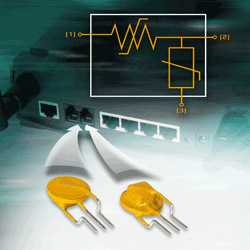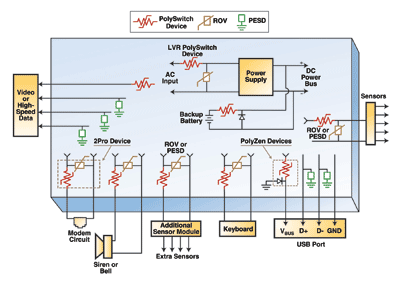Circuit protection for fire alarm, security systems
Security and fire alarm systems have special overvoltage and overcurrent protection needs
BY BARRY BRENTS
Tyco Electronics
Circuit Protection Business Unit
Menlo Park, CA
http://www.raychem.tycoelectronics.com
Security and fire alarm systems are designed for operation within specified current and voltage ratings. If these ratings are exceeded due to short-circuit or voltage transients, components may sustain permanent damage and the equipment may fail. Power supplies and circuit traces must also be protected against faults that may occur during installation or in the case of a shorted back-up battery.

The 2Pro device helps protect against both overcurrent and overvoltage damage.
Modems are frequently used in security systems to automatically alert the fire or police department in an emergency. These telecom lines must be protected from damage caused by lightning strikes, power-line crosses, or ac power induction. Alarm systems must comply with the UL864 standard, which mandates that soldered-in fuses are not allowed to qualify a power supply as inherently limited. If the system provides for connecting to a telephone line it must comply with UL60950 and TIA 968-A in North America, as well as ITU K.21 in Europe and other parts of the world.
Overcurrent protection
Fuses have typically been used for overcurrent protection in security and alarm systems. However, UL864 and UL60950 pose difficult challenges for these devices, which can fatigue under certain test conditions. More important, fuses are single-use components that must be replaced after a fault occurs.
Many equipment manufacturers prefer resettable polymeric positive temperature coefficient (PPTC) devices, such as the PolySwitch device, for circuit protection. Unlike fuses, PPTC devices do not generally require replacement after a fault event, and allow the circuit to return to normal operating condition after the power has been cycled and the overcurrent condition is eliminated.
PPTC devices are made of a composite containing a conductive filler, such as carbon black, that provides conductive chains throughout the device. At normal temperature, the conductive particles form low-resistance networks in the polymer. However, if the temperature rises above the device’s switching temperature (TSW ), either from high current through the part or from an increase in the ambient temperature, the crystallites in the polymer melt and become amorphous.
The increase in volume during melting of the crystalline phase separates the conductive particles, resulting in a large nonlinear increase in the resistance of the device. The resistance typically increases by three or more orders of magnitude. This increased resistance helps protect the equipment in the circuit by reducing the amount of current that can flow under the fault condition to a low, steady-state level.
Because PPTC devices transition to their high-impedance state based on the influence of temperature, they help provide protection for two fault conditions – overcurrent and overtemperature. Overcurrent protection is provided when the PPTC device is heated internally due to I2 R power dissipated within the device. High current levels through the PPTC device heat it internally to its switching temperature, causing it to “trip” and go into a high-impedance state.
The PPTC device can also be caused to trip by thermally linking it to a component or piece of equipment that needs to be protected against overtemperature conditions. If the equipment temperature reaches the PPTC device’s switching temperature, the PPTC device will transition to its high-impedance state, regardless of the current flowing through it. In this way, the device can be used either to reduce the current to very low levels or as an indicator to the control system that the equipment is overheating. The control system can then determine what action is appropriate to protect equipment and personnel.
PPTC devices are employed as series elements in a circuit. Their small form factor helps conserve valuable board space and, in contrast to traditional fuses that require user-accessibility, their resettable functionality allows for placement in inaccessible locations. Because they are solid-state devices, they can also withstand mechanical shock and vibration.
Overvoltage protection
A variety of methods can be used to help protect security and fire alarm systems from overvoltage conditions caused by switching or lightning transients. There are two major categories of overvoltage protection clamping devices and foldback, or “crowbar” devices. Clamping devices, such as metal oxide varistors (MOVs) and diodes, allow voltages up to a specified clamping level to pass through to the load during operation. Foldback devices, such as gas discharge tubes (GDTs) and thyristor surge suppressors, operate as shunt devices in response to a surge that exceeds the breakover voltage.
MOVs provide the high-current handling and energy absorption capability and fast response needed for overvoltage protection in line voltage applications. Pairing an MOV device with a PPTC device can help provide a completely resettable circuit protection solution for power supplies and control board transformers.
Security and fire alarm equipment must also be protected against damage caused by electrostatic discharge (ESD). ESD protection devices can help shunt ESD away from sensitive circuitry in electronic equipment. PESD devices provide ESD protection while also offering a very low (0.2 pF) capacitance, which is useful in high-frequency applications.
New IC protection options
A new generation of polymer-enhanced zener diodes can also help protect sensitive electronics from damage caused by inductive voltage spikes, voltage transients, incorrect power supplies and reverse bias. As shown in Fig. 1 , the PolyZen device incorporates a stable zener diode for crisp voltage clamping and a resistively nonlinear PPTC layer.
In operation, the PPTC layer responds to either diode heating or overcurrent events by transitioning from a low- to high-resistance state. In the event of a sustained high power overvoltage condition, the tripped PPTC element limits current and generates voltage drop to help protect both the zener and the follow on electronics effectively increasing the diode’s power-handling capability.

Fig. 1. Polymer-enhanced zener diode helps provide input power protection for portable electronics.
The PolyZen device is particularly effective at clamping and smoothing inductive voltage spikes. In response to an inductive spike, the zener diode element shunts current to ground until the voltage is reduced to the normal operating range. In the case of a wrong voltage power supply, the device clamps the voltage, shunts excess power to ground, and eventually locks out the wrong supply.
The relatively flat voltage vs. current response of the PolyZen device helps clamp the output voltage, even when input voltage and source currents vary. Simply put, this device helps provide coordinated protection with a component that protects like a zener diode, but can withstand very high power-fault conditions without needing any special heat sinking structures beyond normal PCB traces.
Device integration has resulted in another circuit protection device that can help equipment manufacturers meet the UL60950, TIA-968-A, and ITU K.20 and K.21 telecom protection requirements. The 2Pro device incorporates PPTC overcurrent technology with an MOV component into one thermally protected device that helps provide current limiting during overcurrent events and voltage clamping during overvoltage events.
This integrated device approach helps reduce component count and improve equipment reliability by preventing thermal runaway and maintaining varistor surface temperature at less than 150C, thereby preventing the device from reaching unsafe temperatures that may result from overvoltage transients. The device’s small footprint, resettable functionality and coordinated protection capabilities suit it for a wide range of telephony and security system applications.

Fig. 2. Coordinated circuit protection options for security and fire alarm systems.
Figure 2 illustrates a typical circuit protection solution for security and fire alarm systems, where overcurrent protection is provided by PolySwitch PPTC devices. Overvoltage protection is provided by MOV and PESD devices, and the integrated PolyZen and 2Pro devices described above help protect the equipment’s I/O ports. ■
Advertisement
Learn more about TE Connectivity





